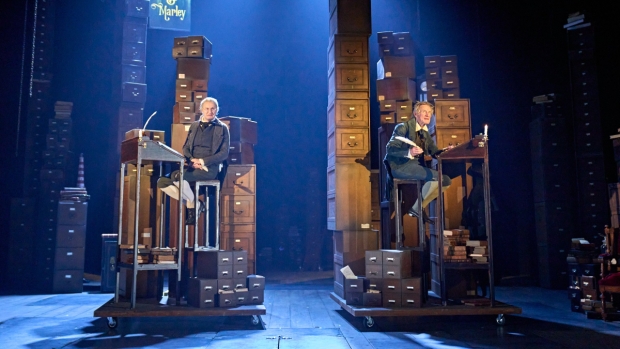A Christmas Carol: A Ghost Story review – Mark Gatiss pens a spooky twist on Dickens' classic
The festive ghost story returns in a new adaptation

© Nottingham Playhouse, photos by Manuel Harlan
"Marley was dead; to begin with. There is no doubt whatever, about that." However, at the beginning of this classy Nottingham Playhouse' production of A Christmas Carol: A Ghost Story, adapted by Mark Gatiss from the popular novella by Charles Dickens, Marley is very much still alive. Directed by Adam Penford, this much-anticipated theatre project has finally dusted off the cripplingly heavy chains and stagnating cobwebs of Covid lockdowns. To the delight of its audiences Present, of the Past and those Yet To Come, A Christmas Carol: A Ghost Story entertains with its ghostly atmospheres and compassionate stories on the Playhouse stage.
Designer Paul Wills gives us a very malleable set incorporating a dark forest of filing cabinets symbolically solid and reaching ever skyward representing vast accumulations of business wealth, business greed, and a great deal of unpayable personal debts historically connected to the firm of Scrooge and Marley. Much is achieved by Philip Gladwell's superb lighting designs, Nina Dunn's thrilling video work, John Bulleid's astonishing stage illusions and an outstanding sound design by Ella Wahlström. From the maws of Hell to Scrooge's counting house, the foggy streets of London, Fezziwig's warehouse, the festive gaiety of nephew Fred's household and the humble Cratchit family's poor abode, this enigmatic production transports us with its magical stream of verbal and visual narratives.
Gatiss's adaptation keeps much of the original text of the well-known classic story yet brings it even more alive by blending in deft verbal brushstrokes of natural language fashioned with such a keen ear for story-telling that he never loses the sense of history by making the conversations too contemporary. Penford's intelligent direction and staging vision incorporates sections of stylised slow movement that suggest the passing of time and brisk social intercourse. This works best at the meagre Christmas Day meal enjoyed by the Cratchits where knives, forks and plates appear to hover fractionally in mid air.
Nicholas Farrell excels as Ebenezer Scrooge as he goes from uncaring miser to magnanimous merry maker over the course of one imaginary Christmas Eve. Farrell's performance steers well away from being over theatrical and the production benefits from his naturalistic portrayal. His final redemption is greeted sympathetically from this enraptured audience. Mark Gatiss is most excellent as Jacob Marley. His suffering ghostly apparition appears to float straight out of one of Boz's inky sketches that graced the original novella. Gatiss's work tends to mix dark comedy and acute human understanding with a touch of macabre. His style is pure Dickensian.
The full cast play 50 characters over 30 scenes and a range of devices are employed to convey the story including singing, dancing, illusion, video and puppetry. There are stand out performances by Zak Ford-Williams (Tiny Tim), Christopher Godwin (narrator), Edward Harrison (Bob Cratchit), Sarah Ridgeway (Mrs Cratchit) and Joe Shire (Ghost of Christmas Present).












